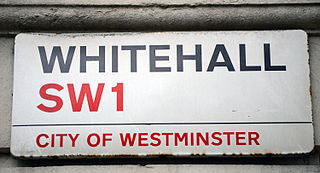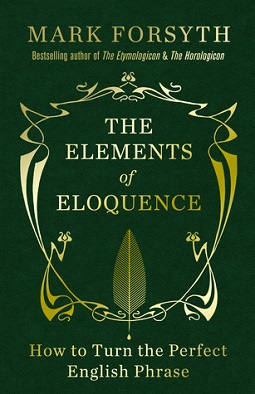Related Research Articles

A figure of speech or rhetorical figure is a word or phrase that intentionally deviates from ordinary language use in order to produce a rhetorical effect. Figures of speech are traditionally classified into schemes, which vary the ordinary sequence of words, and tropes, where words carry a meaning other than what they ordinarily signify.
Antithesis is used in writing or speech either as a proposition that contrasts with or reverses some previously mentioned proposition, or when two opposites are introduced together for contrasting effect. This is based on the logical phrase or term.
Aposiopesis is a figure of speech wherein a sentence is deliberately broken off and left unfinished, the ending to be supplied by the imagination, giving an impression of unwillingness or inability to continue. An example would be the threat "Get out, or else—!" This device often portrays its users as overcome with passion or modesty. To mark the occurrence of aposiopesis with punctuation, an em-rule (—) or an ellipsis (…) may be used.
In rhetoric, a rhetorical device, persuasive device, or stylistic device is a technique that an author or speaker uses to convey to the listener or reader a meaning with the goal of persuading them towards considering a topic from a perspective, using language designed to encourage or provoke an emotional display of a given perspective or action. They seek to make a position or argument more compelling than it would otherwise be.

The Constitution of the Confederate States was the supreme law of the Confederate States of America. It superseded the Provisional Constitution of the Confederate States, the nation's first constitution, in 1862. It remained in effect until the end of the American Civil War in 1865.

In rhetoric, an anaphora is a rhetorical device that consists of repeating a sequence of words at the beginnings of neighboring clauses, thereby lending them emphasis. In contrast, an epistrophe is repeating words at the clauses' ends. The combination of anaphora and epistrophe results in symploce.
Shall and will are two of the English modal verbs. They have various uses, including the expression of propositions about the future, in what is usually referred to as the future tense of English.
Asyndeton is a literary scheme in which one or several conjunctions are deliberately omitted from a series of related clauses. Examples include veni, vidi, vici and its English translation "I came, I saw, I conquered". Its use can have the effect of speeding up the rhythm of a passage and making a single idea more memorable. Asyndeton may be contrasted with syndeton and polysyndeton, which describe the use of one or multiple coordinating conjunctions, respectively.

The English modal verbs are a subset of the English auxiliary verbs used mostly to express modality. They can be distinguished from other verbs by their defectiveness and by their neutralization.

"We shall fight on the beaches" is a common title given to a speech delivered by the British Prime Minister Winston Churchill to the House of Commons of the Parliament of the United Kingdom on 4 June 1940. This was the second of three major speeches given around the period of the Battle of France; the others are the "Blood, toil, tears and sweat" speech of 13 May 1940, and the "This was their finest hour" speech of 18 June 1940. Events developed dramatically over the five-week period, and although broadly similar in themes, each speech addressed a different military and diplomatic context.
In grammar, parallelism, also known as parallel structure or parallel construction, is a balance within one or more sentences of similar phrases or clauses that have the same grammatical structure. The application of parallelism affects readability and may make texts easier to process.

The Silent Sentinels, also known as the Sentinels of Liberty, were a group of over 2,000 women in favor of women's suffrage organized by Alice Paul and the National Woman's Party, who nonviolently protested in front of the White House during Woodrow Wilson's presidency starting on January 10, 1917. Nearly 500 were arrested, and 168 served jail time. They were the first group to picket the White House. Later, they also protested in Lafayette Square, not stopping until June 4, 1919 when the Nineteenth Amendment to the United States Constitution was passed both by the House of Representatives and the Senate.
The enumerated powers of the United States Congress are the powers granted to the federal government of the United States by the United States Constitution. Most of these powers are listed in Article I, Section 8.
Owing to its origin in ancient Greece and Rome, English rhetorical theory frequently employs Greek and Latin words as terms of art. This page explains commonly used rhetorical terms in alphabetical order. The brief definitions here are intended to serve as a quick reference rather than an in-depth discussion. For more information, click the terms.
Repetition is the simple repeating of a word, within a short space of words, with no particular placement of the words to secure emphasis. It is a multilinguistic written or spoken device, frequently used in English and several other languages, such as Hindi and Chinese, and so rarely termed a figure of speech.
The Ordinance of 1784 called for the land in the recently created United States which was located west of the Appalachian Mountains, north of the Ohio River and east of the Mississippi River to be divided into separate states.

This article describes the uses of various verb forms in modern standard English language. This includes:
In rhetoric, parallel syntax is a rhetorical device that consists of repetition among adjacent sentences or clauses. The repeated sentences or clauses provide emphasis to a central theme or idea the author is trying to convey. Parallelism is the mark of a mature language speaker.

The Elements of Eloquence: How to Turn the Perfect English Phrase is a non-fiction book by Mark Forsyth published in 2013. The book explains classical rhetoric, dedicating each chapter to a rhetorical figure with examples of its use, particularly in the works of William Shakespeare. Forsyth argues the power of Shakespeare's language was a result of studying formal rhetoric, and highlights their use through Shakespeare's development.
Brown v. Maryland, 25 U.S. 419 (1827), was a significant United States Supreme Court case which interpreted the Import-Export and Commerce Clauses of the U.S. Constitution to prohibit discriminatory taxation by states against imported items after importation, rather than only at the time of importation. The state of Maryland passed a law requiring importers of foreign goods to obtain a license for selling their products. Brown was charged under this law and appealed. It was the first case in which the U.S. Supreme Court construed the Import-Export Clause. Chief Justice John Marshall delivered the opinion of the court, ruling that Maryland's statute violated the Import-Export and Commerce Clauses and the federal law was supreme. He alleged that the power of a state to tax goods did not apply if they remained in their "original package". A license tax on the importer was essentially the same as a tax on an import itself. Despite arguing the case for Maryland, future chief justice Roger Taney admitted that the case was correctly decided.
References
- ↑ Matthew of Vendôme (1980). The art of versification. Translated by Aubrey E. Galyon. Iowa State University Press. p. 29. ISBN 0813813700.